List of mayors of New York City
The mayor of New York City is the chief executive of the Government of New York City, as stipulated by New York City's charter. The current officeholder, the 110th in the sequence of regular mayors, is Eric Adams, a member of the Democratic Party.
During the Dutch colonial period from 1624 to 1664, New Amsterdam was governed by the Director of New Netherland. Following the 1664 creation of the British Province of New York, newly renamed New York City was run by the British military governor, Richard Nicolls. The office of Mayor of New York City was established in 1665. Holders were appointed by colonial governors, beginning with Thomas Willett. The position remained appointed until 1777. That year, during the American Revolution, a Council of Appointment was formed by the State of New York. In 1821 the New York City Council – then known as the Common Council – began appointing mayors. Since 1834, mayors have been elected by direct popular vote.[1]
The city included little beyond the island of Manhattan before 1874, when it annexed the western part of the Bronx, to be followed in 1895 by the rest of the Bronx. The 1898 consolidation created the city as it is today with five boroughs: Manhattan, the Bronx, Brooklyn, Queens, and Staten Island. The first mayor of the expanded city was Robert Anderson Van Wyck.
The longest-serving mayors have been Fiorello H. La Guardia (1934–1945), Robert F. Wagner Jr. (1954–1965), Ed Koch (1978–1989) and Michael Bloomberg (2002–2013), each of whom was in office for twelve years (three successive four-year terms). The shortest terms in office since 1834 have been those of acting mayors: William T. Collins served a single day on December 31, 1925, Samuel B. H. Vance served one month (from November 30 to December 31, 1874), and Thomas Coman served five weeks (from Monday, November 30, 1868, to Monday, January 4, 1869).
Colonial mayors (1665–1783)
[edit]Before 1680, mayors served one-year terms. From 1680, they served two-year terms. Exceptions are noted thus (*). A dagger (†) indicates mayoralties cut short by death in office. (When the same man served more than one continuous term, his name is lightly shaded purely for clarity, but the tints have no other significance.)
| No.[2] | Name | Starting year of office | Ending year of office |
|---|---|---|---|
| 1 | Thomas Willett (1st term) | 1665 | 1666 |
| 2 | Thomas Delavall (1st term) | 1666 | 1667 |
| 3 | Thomas Willett (2nd term) | 1667 | 1668 |
| 4 | Cornelius Van Steenwyk (1st term) | 1668 | 1671 |
| 5 | Thomas Delavall (2nd term) | 1671 | 1672 |
| 6 | Matthias Nicoll | 1672 | 1673 |
| 7 | John Lawrence (1st term) | 1673 | 1675 |
| 8 | William Dervall | 1675 | 1676 |
| 9 | Nicholas De Mayer | 1676 | 1677 |
| 10 | Stephanus Van Cortlandt (1st term) | 1677 | 1678 |
| 11 | Thomas Delavall (3rd term) | 1678 | 1679 |
| 12 | Francis Rombouts | 1679 | 1680 |
| 13 | William Dyre | 1680 | 1682 |
| 14 | Cornelius Van Steenwyk (2nd term) | 1682 | 1684 |
| 15 | Gabriel Minvielle (*) | 1684 | 1685 |
| 16 | Nicholas Bayard (*) | 1685 | 1686 |
| 17 | Stephanus Van Cortlandt (2nd term) | 1686 | 1688 |
| 18 | Peter Delanoy (only popularly-elected mayor before 1834) 1 |
1689 | 1691 |
| 19 | John Lawrence (2nd term *) | 1691 | 1691 |
| 20 | Abraham de Peyster | 1691 | 1694 |
| 21 | Charles Lodwik | 1694 | 1695 |
| 22 | William Merritt | 1695 | 1698 |
| 23 | Johannes de Peyster | 1698 | 1699 |
| 24 | David Provost | 1699 | 1700 |
| 25 | Isaac De Riemer | 1700 | 1701 |
| 26 | Thomas Noell | 1701 | 1702 |
| 27 | Phillip French | 1702 | 1703 |
| 28 | William Peartree | 1703 | 1707 |
| 29 | Ebenezer Wilson | 1707 | 1710 |
| 30 | Jacobus Van Cortlandt (1st term) | 1710 | 1711 |
| 31 | Caleb Heathcote | 1711 | 1714 |
| 32 | John Johnstone | 1714 | 1719 |
| 33 | Jacobus Van Cortlandt (2nd term) | 1719 | 1720 |
| 34 | Robert Walters | 1720 | 1725 |
| 35 | Johannes Jansen | 1725 | 1726 |
| 36 | Robert Lurting † | 1726 | 1735 |
| 37 | Paul Richard | 1735 | 1739 |
| 38 | John Cruger † | 1739 | 1744 |
| 39 | Stephen Bayard | 1744 | 1747 |
| 40 | Edward Holland † | 1747 | 1757 |
| 41 | John Cruger Jr. | 1757 | 1766 |
| 42 | Whitehead Hicks | 1766 | 1776 |
| 43 | David Mathews | 1776 | 1783 |
Note
- Peter Delanoy was the first and only directly-elected mayor of New York[3] until 1834. Appointed mayors resumed in the wake of Leisler's Rebellion.
† died in office
Pre-consolidation mayors (1784–1897)
[edit]The mayor continued to be selected by the Government of New York's Council of Appointment until 1821, when Stephen Allen became the first mayor appointed by a local Common Council. Under the Charter of 1834, mayors were elected annually by direct popular vote. Starting in 1849, mayors were elected to serve two-year terms.
| # | Portrait | Mayor | Term start | Term end | Terms | ||
|---|---|---|---|---|---|---|---|
| 44 | 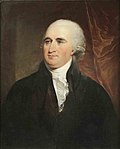
|
James Duane | January 1, 1784 | 1789 | 5 | None | |
| 45 | 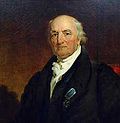
|
Richard Varick | 1789 | 1801 | 11 | Federalist | |
| 46 | 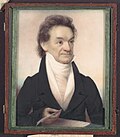
|
Edward Livingston | 1801 | 1803 | 2 | Democratic-Republican | |
| 47 | 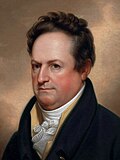
|
DeWitt Clinton (1st term) | 1803 | 1807 | 4 | Democratic-Republican | |
| 48 | 
|
Marinus Willett | 1807 | 1808 | 1 | Democratic-Republican[4] | |
| 49 | 
|
DeWitt Clinton (2nd term) | 1808 | 1810 | 2 | Democratic-Republican | |
| 50 | 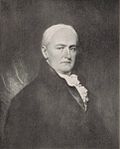
|
Jacob Radcliff (1st term) | 1810 | 1811 | 1 | Federalist | |
| 51 | 
|
DeWitt Clinton (3rd term) | 1811 | 1815 | 4 | Democratic-Republican | |
| 52 | 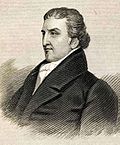
|
John Ferguson | 1815 | 1815 | 1⁄2 | Democratic-Republican | |
| 53 | 
|
Jacob Radcliff (2nd term) | February 13, 1815 | 1818 | 3 | Federalist | |
| 54 | 
|
Cadwallader D. Colden | 1818 | 1821 | 3 | Federalist | |
| 55 | 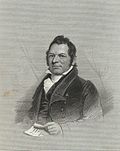
|
Stephen Allen | 1821 | 1824 | 3 | Federalist | |
| 56 | 
|
William Paulding Jr. (1st term) | 1825 | 1826 | 1 | Democratic-Republican | |
| 57 | 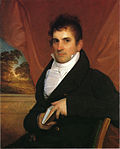
|
Philip Hone | 1826 | 1827 | 1 | National Republican | |
| 58 | 
|
William Paulding Jr. (2nd term) | 1827 | 1829 | 2 | Democratic-Republican | |
| 59 | 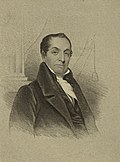
|
Walter Bowne | 1829 | 1832 | 3 | Democratic | |
| 60 | 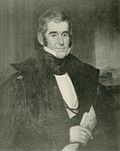
|
Gideon Lee | 1833 | 1834 | 1 | Democratic | |
| 61 | 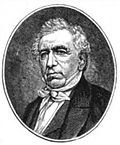
|
Cornelius Lawrence | 1834 | 1837 | 3 | Democratic | |
| 62 | 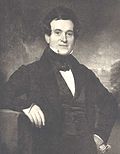
|
Aaron Clark | 1837 | 1839 | 2 | Whig | |
| 63 | 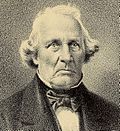
|
Isaac L. Varian | 1839 | 1841 | 2 | Democratic | |
| 64 | 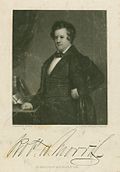
|
Robert H. Morris | 1841 | 1844 | 3 | Democratic | |
| 65 | 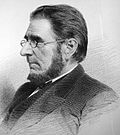
|
James Harper | 1844 | 1845 | 1 | American Republican | |
| 66 | 
|
William F. Havemeyer (1st term) | 1845 | 1846 | 1 | Democratic | |
| 67 | 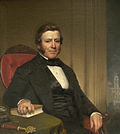
|
Andrew H. Mickle | 1846 | 1847 | 1 | Democratic | |
| 68 | 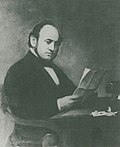
|
William V. Brady | 1847 | 1848 | 1 | Whig | |
| 69 | 
|
William F. Havemeyer (2nd term) | 1848 | 1849 | 1 | Democratic | |
| 70 | 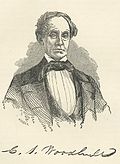
|
Caleb S. Woodhull | 1849 | 1851 | 1 | Whig | |
| 71 | 
|
Ambrose Kingsland | 1851 | 1853 | 1 | Whig | |
| 72 | 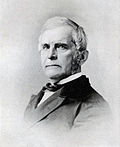
|
Jacob A. Westervelt | 1853 | 1855 | 1 | Democratic | |
| 73 | 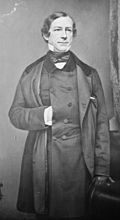
|
Fernando Wood (1st term) | 1855 | 1858 | 2 | Democratic | |
| 74 | 
|
Daniel F. Tiemann | 1858 | 1860 | 1 | Independent Party[5][6][7] | |
| 75 | 
|
Fernando Wood (2nd term) | 1860 | 1862 | 1 | Democratic | |
| 76 | 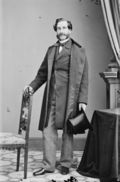
|
George Opdyke | 1862 | 1864 | 1 | Republican | |
| 77 | 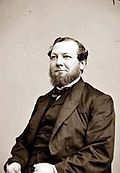
|
Charles G. Gunther | 1864 | 1866 | 1 | Democratic | |
| 78 | 
|
John T. Hoffman1 | 1866 | November 30, 1868 | less than 1 | Democratic | |
| Acting | 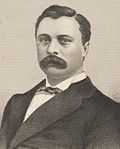
|
Thomas Coman 1 | November 30, 1868 | January 4, 1869 | 5 weeks | Democratic | |
| 79 | 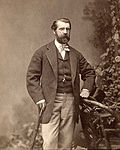
|
Abraham Oakey Hall 2 | January 4, 1869 | December 31, 1872 | 1 | Democratic | |
| 80 | 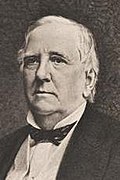
|
William F. Havemeyer 3(3rd term) † | January 1, 1873 | November 30, 1874 | less than 1 | Republican | |
| Acting | 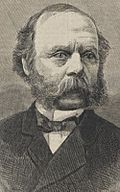
|
Samuel B. H. Vance 3 | November 30, 1874 | December 31, 1874 | 1 month | Republican | |
| 81 | 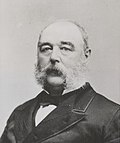
|
William H. Wickham | January 1, 1875 | December 31, 1876 | 1 | Democratic (Reform) | |
| 82 | 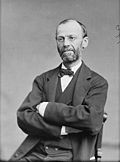
|
Smith Ely Jr. | 1877 | 1878 | 1 | Democratic | |
| 83 | 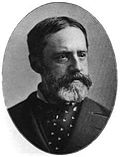
|
Edward Cooper | 1879 | 1880 | 1 | Democratic (Reform) | |
| 84 | 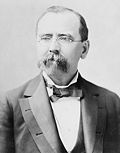
|
William R. Grace (1st term) | 1881 | 1882 | 1 | Democratic (Reform) | |
| 85 | 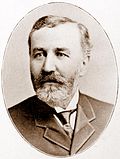
|
Franklin Edson | 1883 | 1884 | 1 | Democratic | |
| 86 | 
|
William R. Grace (2nd term) | 1885 | 1886 | 2 | None | |
| 87 | 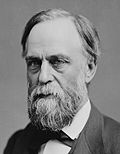
|
Abram Hewitt | 1887 | 1888 | 1 | Democratic | |
| 88 | 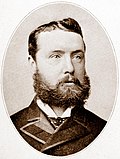
|
Hugh J. Grant | 1889 | 1892 | 2 | Democratic | |
| 89 | 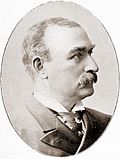
|
Thomas F. Gilroy | 1893 | 1894 | 1 | Democratic | |
| 90 | 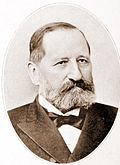
|
William L. Strong 4 | January 1, 1895 | December 31, 1897 | 1 (3 years) |
Republican |
Notes
- John T. Hoffman resigned after his election as Governor of New York state but before the end of his mayoral term.[8] Thomas Coman, President of the Board of Aldermen, completed Hoffman's term as acting mayor until his elected successor, A. Oakey Hall, took office.[9]
- When Hall temporarily retired during the Tweed investigation, the Acting Mayor of New York City was John Cochrane, the President of the New York City Council.
- William F. Havemeyer died during his last term of office. Samuel B. H. Vance, President of the Board of Aldermen, completed Havemeyer's term as acting mayor until his elected successor, William H. Wickham, took office.
- William L. Strong served an additional year in office because New York City mayoral elections were changed to be held in odd-numbered years due to the impending consolidation of New York City.
† died in office
Post-consolidation mayors (since 1897)
[edit]The 1898–1901 term was for four years. The City Charter was changed to make the mayor's term a two-year one beginning in 1902, but after two such terms was changed back to resume four-year terms in 1906. George B. McClellan Jr. thus served one two-year term from 1904 to 1905, during which he was elected to a four-year term from 1906 to 1909.
The party of the mayor reflects party registration, as opposed to the party lines run under during the general election.
| No. | Portrait | Name (Birth–Death) |
Term | Party | Election | Previous office | |
|---|---|---|---|---|---|---|---|
| 91 | 
|
Robert Anderson Van Wyck1 (1849–1918) |
January 1, 1898 – December 31, 1901 |
Democratic | 1897 | Chief Justice of the City Court of New York[10] | |
| 92 | 
|
Seth Low 2 (1850–1916) |
January 1, 1902 – December 31, 1903 |
Republican | 1901 | 11th President of Columbia University (1890–1901) | |
| 93 | 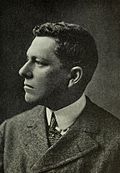
|
George B. McClellan Jr. (1865–1940) |
January 1, 1904 – December 31, 1909 |
Democratic | 1903 1905 |
Member of the U.S. House of Representatives from New York (1895–1903) | |
| 94 | 
|
William Jay Gaynor 3 † (1849–1913) |
January 1, 1910 – September 10, 1913 |
Democratic | 1909 | Justice of the New York Supreme Court (1893–1909) | |
| Acting3 | 
|
Ardolph L. Kline (1858–1930) |
September 10, 1913 – December 31, 1913 |
Republican | – | President of the Board of Aldermen (1913) | |
| 95 | 
|
John P. Mitchel (1879–1918) |
January 1, 1914 – December 31, 1917 |
Republican | 1913 | Collector of the Port of New York (1913) | |
| 96 | 
|
John F. Hylan 4,[11] (1868–1936) |
January 1, 1918 – December 31, 1925 |
Democratic | 1917 1921 |
Judge in Kings County[12] | |
| Acting4 | 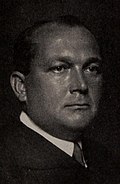
|
William T. Collins (1886-1961) |
December 31, 1925[11] | Democratic | – | President of the Board of Aldermen[11] (1925) | |
| 97 | 
|
Jimmy Walker 5 (1881–1946) |
January 1, 1926 – September 1, 1932 |
Democratic | 1925 1929 |
Member of the New York State Senate (1919–1925) | |
| Acting5 | 
|
Joseph V. McKee (1889–1956) |
September 1, 1932 – December 31, 1932 |
Democratic | – | President of the Board of Aldermen (1926–1933) | |
| 98 | 
|
John P. O'Brien (1873–1951) |
January 1, 1933 – December 31, 1933 |
Democratic | 1932 | Surrogate of New York County[13] | |
| 99 | 
|
Fiorello La Guardia (1882–1947) |
January 1, 1934 – December 31, 1945 |
Republican[14] | 1933 1937 1941 |
Member of the U.S. House of Representatives from New York (1923–1933) | |
| 100 | 
|
William O'Dwyer 6 (1890–1964) |
January 1, 1946 – August 31, 1950 |
Democratic | 1945 1949 |
District Attorney for Kings County (1940–1942; 1945) | |
| 101 | 
|
Vincent R. Impellitteri 6 (1900–1987) |
November 14, 1950 – December 31, 1953 (acting from August 31, 1950) |
Democratic | 1950 | President of the City Council (1946–1950) | |
| 102 | 
|
Robert F. Wagner Jr. (1910–1991) |
January 1, 1954 – December 31, 1965 |
Democratic | 1953 1957 1961 |
17th Borough President of Manhattan (1950–1953) | |
| 103 | 
|
John Lindsay (1921–2000) |
January 1, 1966 – December 31, 1973 |
Republican 8 Democratic |
1965 1969 |
Member of the U.S. House of Representatives from New York (1959–1965) | |
| 104 | 
|
Abraham Beame (1906–2001) |
January 1, 1974 – December 31, 1977 |
Democratic | 1973 | 36th and 38th New York City Comptroller (1962–1965; 1970–1973) | |
| 105 | 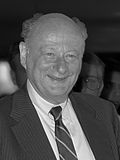
|
Ed Koch (1924–2013) |
January 1, 1978 – December 31, 1989 |
Democratic | 1977 1981 1985 |
Member of the U.S. House of Representatives from New York (1969–1977) | |
| 106 | 
|
David Dinkins (1927–2020) |
January 1, 1990 – December 31, 1993 |
Democratic | 1989 | 23rd Borough President of Manhattan (1986–1989) | |
| 107 | 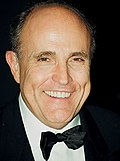
|
Rudy Giuliani (b. 1944) |
January 1, 1994 – December 31, 2001 |
Republican | 1993 1997 |
U.S. Attorney for the Southern District of New York (1983–1989) | |
| 108 | 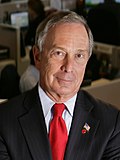
|
Michael Bloomberg (b. 1942) |
January 1, 2002 – December 31, 2013 |
Republican Unaffiliated |
2001 2005 2009 |
CEO of Bloomberg L.P. (1981–2001) | |
| 109 | 
|
Bill de Blasio (b. 1961) |
January 1, 2014 – December 31, 2021 |
Democratic | 2013 2017 |
3rd New York City Public Advocate (2010–2013) | |
| 110 | 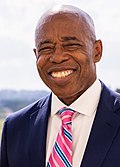
|
Eric Adams 10 (b. 1960) |
January 1, 2022 – Incumbent |
Democratic | 2021 | 18th Borough President of Brooklyn (2014–2021) | |
Notes
- Randolph Gugghenheimer I (born 1846) served as acting mayor in 1900 while Robert A. Van Wyck was away.[15][16]
- Seth Low previously served as Mayor of the City of Brooklyn from 1882 to 1885.
- William Jay Gaynor died September 10, 1913. Ardolph L. Kline, the unelected President of the Board of Aldermen, succeeded as acting mayor upon Gaynor's death, but then sought re-election as an alderman (successfully) rather than election as mayor. Kline has thus been the only mayor since 1834 never to win a citywide election (having been appointed Vice President of the Board of Aldermen by his colleagues and then succeeding to the presidency mid-term, rather than winning it by popular election at large).
- John Hylan and Police Commissioner Richard Enright resigned December 30, 1925 to ensure that they received their city pensions, which they may not have been entitled to keep had they stayed in office for one more day. William T. Collins became acting Mayor for one day, prior to the inauguration of Jimmy Walker[11]
- Jimmy Walker resigned September 1, 1932 and went to Europe, amid allegations of corruption in his administration. Joseph V. McKee, as President of the Board of Aldermen, became acting mayor in Walker's place, but was then defeated in a special election by John P. O'Brien.
- William O'Dwyer resigned August 31, 1950, during a police corruption scandal, after which he was appointed Ambassador to Mexico by President Harry S. Truman.
- Vincent R. Impellitteri, President of the New York City Council, became acting mayor when O'Dwyer resigned on August 31, 1950, and was then elected to the office in a special election held on November 7, 1950. He was inaugurated on November 14.
- John Lindsay switched party affiliation from Republican to Democrat in 1971 and ran unsuccessfully for the Democratic nomination for president in 1972.[17]
- Michael Bloomberg was a lifelong Democrat before registering as a Republican in 2001 and running for mayor. He then registered as an Independent in 2007, and re-registered as a Democrat in 2018 in preparation for his unsuccessful bid for the Democratic nomination for president in 2020.[18]
- Eric Adams is the first sitting mayor of New York City to ever face indictment; he faces two charges of solicitation of a contribution from a foreign national, as well as charges of wire fraud, conspiracy, and bribery.[19]
† died in office
Appendices
[edit]Mayoral terms and term limits in New York City since 1834
[edit]Direct elections to the mayoralty of the unconsolidated City of New York began in 1834 for a term of one year, extended to two years after 1849. The 1897 Charter of the consolidated City stipulated that the mayor was to be elected for a single four-year term. In 1901, the term halved to two years, with no restrictions on reelection. In 1905, the term was extended to four years once again. (Mayors Fiorello La Guardia, Robert F. Wagner Jr. and Ed Koch were later able to serve for twelve years each.) [20] In 1993, the voters approved a two-term (eight-year) limit, and reconfirmed this limit when the issue was submitted to referendum in 1996. In 2008, the New York City Council voted to change the two-term limit to three terms (without submitting the issue to the voters).[21] Legal challenges to the Council's action were rejected by Federal courts in January and April 2009.[22] However, in 2010, yet another referendum, reverting the limit to two terms, passed overwhelmingly.[23]
| Year | Term | Term limit |
Years | Mayor(s) affected |
|---|---|---|---|---|
Unconsolidated City
| ||||
| 1834 | 1 year | (no limit) | (unlimited) | all from Cornelius Van Wyck Lawrence to Caleb S. Woodhull |
| 1849 | 2 years | (no limit) | (unlimited) | all from Ambrose Kingsland to William L. Strong 1 |
Greater New York (The Five Boroughs)
| ||||
| 1897 | 4 years | 1 term |
4 years |
Robert A. Van Wyck |
| 1901 | 2 years | (no limit) | (unlimited) | Seth Low and George B. McClellan Jr.2 |
| 1905 | 4 years | (no limit) | (unlimited) | all from George B. McClellan Jr.2 to David Dinkins 3 |
| 1993 | 4 years | 2 terms |
8 years |
Rudolph Giuliani 4 |
| 2008 | 4 years | 3 terms |
12 years |
Michael Bloomberg only 4, 5 |
| 2010 | 4 years | 2 terms |
8 years |
Bill de Blasio and his successors 6 |
Principal source: The Encyclopedia of New York City [24] especially the entries for "charter" and "mayoralty".
- Mayor Strong, elected in 1894, served an extra year because no municipal election was held in 1896, in anticipation of the consolidated City's switch to odd-year elections.
- George B. McClellan Jr. was elected to one two-year term (1904–1906) and one four-year term (1906-1910).
- David Dinkins was not affected by the term limit enacted in 1993 because he had served only one term by 1993 and failed to win re-election.
- The September 11 attacks on the World Trade Center in Manhattan coincided with the primary elections for a successor to Mayor Giuliani, who was completing his second and final term of office. Many were so impressed by both the urgency of the situation and Giuliani's response that they wanted to keep him in office beyond December 31, 2001, either by removing the term limit or by extending his service for a few months.[25] However, neither happened, the primary elections (with the same candidates) were re-run on September 25, the general election was held as scheduled on November 6, and Michael Bloomberg took office on the regularly appointed date of January 1, 2002.
- On October 2, 2008, Michael Bloomberg announced that he would ask the city council to extend the limit for mayor, council and other officers from two terms to three, and that, should such an extended limit prevail, he himself would seek re-election as mayor.[26] On October 23, the New York City Council voted 29–22 to extend the two-term limit to three terms. (A proposed amendment to submit the vote to a public referendum had failed earlier the same day by a vote of 22–28 with one abstention.)[21]
- In November 2010, yet another popular referendum, limiting mayoral terms to two, passed overwhelmingly.[23]
Interrupted terms
[edit]Mayors John T. Hoffman (1866–1868, elected Governor 1868), William Havemeyer (1845–1846, 1848–1849, and 1873–1874), William Jay Gaynor (1910–1913), John Francis Hylan (1918–1925), Jimmy Walker (1926–1932), and William O'Dwyer (1946–1950) failed to complete the final terms to which they were elected. The uncompleted mayoral terms of Hoffman, Walker, and O'Dwyer were added to the other offices elected in (respectively) 1868, 1932, and 1950 [those three elections are listed as "special" in the table below because they occurred before the next regularly scheduled mayoral election; the "regular" mayoral elections of 1874 and 1913, on the other hand, were held on the same day that they would have happened had the mayoralty not become vacant.]
Interrupted terms of New York City's elected mayors since 1834
| |||||
Elected mayor
|
Last elected
|
End of service
|
Interim successor † 1, 2
|
Election
|
Elected successor 3
|
John T. Hoffman (D) |
Dec. 1867 |
resigned November 30, 1868 |
Thomas Coman (D) |
Dec. 1868 (special) | A. Oakey Hall (D) |
1 Wm Havemeyer (R) |
Nov. 1872 |
died November 30, 1874 |
Nov. 1874 (regular) | William H. Wickham (D) | |
William Gaynor (D) |
died September 10, 1913 |
Ardolph L. Kline (R) |
Nov. 1913 (regular) | John P. Mitchel (Fusion) | |
John F. Hylan (D) |
Nov. 1921 |
resigned December 30, 1925 |
Nov. 1925 (regular) | Jimmy Walker (D) | |
Jimmy Walker (D) |
resigned September 1, 1932 |
Joseph V. McKee (D) |
Nov. 1932 (special) | John P. O'Brien (D) | |
William O'Dwyer (D) |
resigned August 31, 1950 |
Nov. 1950 (special) | Vincent Impellitteri (Experience) | ||
† Became acting mayor as the president of the board of aldermen or (in 1950) city council.
(D) = (Democratic)
(R) = (Republican)
- Mayor Havemeyer was a Democrat who ran as a Republican against the Democratic Tweed Ring in 1872.
- Acting Mayors Coman, Vance, Kline and Collins did not seek election as mayor.
- Acting Mayors McKee and Impellitteri were Democrats who lost the Democratic primary to succeed themselves, but still ran in the general election as independents.
- Elected Mayor Oakey Hall won re-election, while Mayor Wickham did not seek it. Mayors Mitchel and O'Brien lost attempts at re-election, while Mayor Impellitteri did not run for a full term in the 1953 regular general election after losing the Democratic primary.
Mayors of the City of Brooklyn, 1834–1897
[edit]Brooklyn elected a mayor from 1834 until consolidation in 1898 into the City of Greater New York, whose own second mayor (1902–1903), Seth Low, had been Mayor of Brooklyn from 1882 to 1885. Since 1898, Brooklyn has, in place of a separate mayor, elected a Borough President.
Mayors of Long Island City, 1870–1897
[edit]Long Island City, now within the Borough of Queens, was incorporated as a city in its own right on May 4, 1870 and (like the City of Brooklyn) consolidated into the present Greater New York City on January 1, 1898.
| No. | Name | Starting year of office | Ending year of office |
|---|---|---|---|
| 1 | Abram D. Ditmars (1st term) | 1870 | 1872 |
| 2 | Henry S. DeBevoise (1st term) | 1872 | 1873 Sept. |
| (-) | George H. Hunter (acting) | 1873 Sept. | 1874 April |
| 2 | Henry S. DeBevoise (1st term resumed) | 1874 April | 1875 |
| 3 | Abram D. Ditmars (2nd term) | 1875 | |
| (-) | John Quinn (acting) | 1876 | |
| 4 | Henry S. DeBevoise (2nd term) | 1876 | 1883 |
| 5 | George Petry | 1883 | 1886 |
| 6 | Patrick J. Gleason (1st term) | 1887 | 1889 |
| Patrick J. Gleason (2nd term) | 1890 | 1892 | |
| 7 | Horatio S. Sanford | 1893 | 1895 |
| 8 | Patrick J. Gleason (3rd term) | 1895 | 1897 |
| Sources: James Bradley for The Encyclopedia of New York City (1st edition), edited by Kenneth T. Jackson (Yale University Press and The New York Historical Society, New Haven, Connecticut, 1995, ISBN 0-300-05536-6); (p. 690, 3rd Column, under "Long Island City"); James Nevlus, Long Island City's Forgotten History (Curbed New York, November 16, 2018) https://ny.curbed.com/2018/11/16/18097555/amazon-hq2-long-island-city-nyc-history | |||
See also
[edit]- Election results for Mayor of New York
- History of New York City
- History of Brooklyn
- List of governors of New York
References
[edit]- ^ Lincoln, Charles Z. (1906). The Constitutional History of New York: From the Beginning of the Colonial Period to the Year 1905, Showing the Origin, Development, and Judicial Construction of the Constitution – Volume 2. Rochester, N.Y.: The Lawyers Co-operative Publishing Company. p. 6. Retrieved December 26, 2016.
- ^ "The Green Book: Mayors of the City of New York" Archived March 22, 2014, at the Wayback Machine on the official NYC website. When a former mayor serves again after a break in office, a new number is assigned to his resumed service. However, the six acting mayoralties are unnumbered.
- ^ Burrows, Edwin G. and Wallace, Mike (1999). Gotham: A History of New York City to 1898. New York: Oxford University Press. ISBN 0-195-11634-8. pp.99–100
- ^ Caldwell, John; Rogue, Oswaldo Rodriguez; Johnson, Dale T. (March 1, 1994). American Paintings in The Metropolitan Museum of Art. Vol. 1. Metropolitan Museum of Art. p. 256.
- ^ Mooney, James E. "Tiemann, Daniel F(awcett)" in Jackson, Kenneth T., ed. (2010). The Encyclopedia of New York City (2nd ed.). New Haven: Yale University Press. pp. 1314–15. ISBN 978-0-300-11465-2.
- ^ Burrows, Edwin G. and Wallace, Mike (1999). Gotham: A History of New York City to 1898. New York: Oxford University Press. pp. 850–51. ISBN 0-195-11634-8.
- ^ Trager, James (2003), The New York Chronology, New York: HarperCollins, p. 113, ISBN 0-06-074062-0
- ^ Staff (November 17, 1868). "Local Intelligence — Board of Aldermen — Resignation of the Mayor". The New York Times. p. 2. Retrieved December 15, 2016.
- ^ Staff (January 5, 1869). "Municipal Affairs — Organization of the Common Council — The Mayor's Message — The City Budget for 1869 — Comparison of Taxation in 1868 and 1869". The New York Times. p. 2. Retrieved December 15, 2016.
- ^ Staff (November 7, 1897). "Robert A. Van Wyck". The New York Times Magazine. p. 2. Retrieved December 28, 2016.
- ^ a b c d Staff (December 31, 1925). "Hylan And Enright Out With Pensions; Last-Hour Shifts In Police Department; Walker Fills Important City Posts — Collins Mayor for a Day — Leach is the Active Head of the Police Force for the Last Day of 1925 — Hylan to Get $4,205 A Year — Retirement Voted by Board of Estimate, He Quits to Assure Pension — Enright to Draw $5,000 — Approval of His Retirement as Commissioner One of Hylan's Last Official Acts". The New York Times. p. 1. Retrieved August 19, 2016.
- ^ Staff (November 7, 1917). "How Hylan Reached The Mayor's Chair — Came Here from the Farm and First Worked as a Tracklayer — To School After Marriage — Long Active in Civic Affairs in Brooklyn — Mayoralty Said to Have Been His Ambition". The New York Times. p. 5. Retrieved December 28, 2016.
- ^ Staff (November 10, 1932). "O'Brien Will Stay on Bench Till Jan. 1 — Mayor-Elect Says, However, He Will Devote Spare Time to Study of City's Problems — Renews Economy Pledge — Silent on Protest Vote — McKee Among Thousands Who Send Congratulatory Messages". The New York Times. p. 5. Retrieved December 28, 2016.
- ^ Staff (November 5, 1933). "List of Candidates Who Will Be on Ballots in Municipal Election Nov. 7". The New York Times. p. N2. Retrieved August 19, 2016.
- ^ "Acting Mayor Boomed Long Branch Property by Buying Drexel Cottage". The New York Times. August 20, 1900. Retrieved February 1, 2018.
- ^ "Randolph Gugghenheimer". Jewish Encyclopedia.
Guggenheimer acted as mayor of New York city during the absence of the incumbent.
- ^ "Lindsay the Democrat". The New York Times. August 12, 1971. Retrieved November 24, 2020.
- ^ Wise, Justin (October 10, 2018). "Bloomberg re-registers as Democrat". The Hill. Retrieved December 27, 2018.
- ^ "Read the full indictment against New York Mayor Eric Adams". PBS News. September 26, 2024. Retrieved September 26, 2024.
- ^ For further details, see Third Term No Charm, Historians Say by Sewell Chan, The New York Times "City Room", published and retrieved on October 1, 2008.
- ^ a b Sewell Chan and Jonathan P. Hicks, Council Votes, 29 to 22, to Extend Term Limits, The New York Times, published on-line and retrieved on October 23, 2008.
- ^ Fernanda Santos: The Future of Term Limits Is in Court, The New York Times, New York edition, October 24, 2008, page A24 (retrieved on October 24, 2008), Judge Rejects Suit Over Term Limits, The New York Times, New York edition, January 14, 2009, page A26, and Appeals Court Upholds Term Limits Revision, The New York Times City Room Blog, April 28, 2009 (both retrieved on July 6, 2009). The original January decision by Judge Charles Sifton of the United States District Court for the Eastern District of New York (Long Island, Brooklyn, Queens and Staten Island) was upheld by a three-judge panel of the United States Court of Appeals for the Second Circuit (Vermont, Connecticut and New York state).
- ^ a b Hernandez, Javier C. (November 3, 2010). "Term Limits in New York City Are Approved Again". The New York Times.
- ^ “The Encyclopedia of New York City (1st edition), edited by Kenneth T. Jackson (Yale University Press and The New York Historical Society, New Haven, Connecticut, 1995, ISBN 0-300-05536-6 )
- ^ See, for example, these stories from The New York Times: "In Crisis Giuliani’s Popularity Overflows City", by Jennifer Steinhauer, September 20, 2001, "A Shift in the Ritual, and Meaning, of Voting", by Mirta Ojito, September 26, 2001 and "Giuliani Explores A Term Extension Of 2 Or 3 Months", by Jennifer Steinhauer with Michael Cooper, September 27, 2001.
- ^ Sewell Chan, Bloomberg Says He Wants a Third Term as Mayor, The New York Times, published and retrieved on October 2, 2008.
- ^ “The Encyclopedia of New York City (1st edition), edited by Kenneth T. Jackson (Yale University Press and The New York Historical Society, New Haven, Connecticut, 1995, ISBN 0-300-05536-6 ); (p. 149, 3rd Column.)
External links
[edit] Media related to Mayors of New York City at Wikimedia Commons
Media related to Mayors of New York City at Wikimedia Commons
Lua error in Module:Navbox at line 535: attempt to get length of local 'arg' (a number value). Lua error in Module:Navbox at line 535: attempt to get length of local 'arg' (a number value). Lua error in Module:Navbox at line 535: attempt to get length of local 'arg' (a number value).
